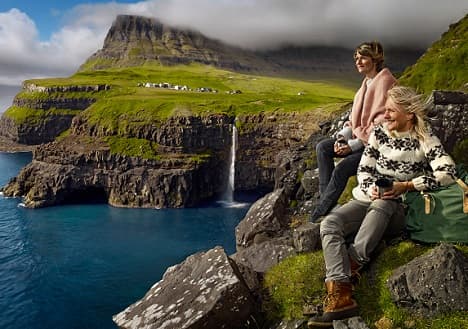Gudrun Rógvadóttir: 'We're Nordic, and that's a huge advantage'
Ever heard of Faroese wool? Gudrun Rógvadóttir tells The Local about life on the Faroe Islands, tradition, and how a unique jumper epitomizes the Nordic-but-not nature of this isolated society.

There’s not a whole lot from the Faroe Islands – a exotic array of 18 islands adrift in the vast sea separating Norway from Iceland – that has achieved international fame.
But if anything has, it’s a certain wool sweater.
“It was really all just luck. We had no idea that it would get so much attention,” says unlikely Faroese fashion-phenom Gudrun Rógvadóttir of the sweater in question. You know, the one worn by character Sarah Lund on the hit TV show The Killing.
“The styling scout found us at a fair in Denmark, but we forgot all about it afterwards. And suddenly the next summer we were basically tour guides, meeting with The Guardian, The Independent, Times magazine, and more.”
Rógvadóttir and her friend Gudrun Ludvig were at the fair to promote their new company Gudrun and Gudrun, focused on creating fashion from natural Faroese products. But the little sweater that could was just an accident: their work actually began with lamb skins.
“I found it a pity that our natural materials, lamb skins and wools, weren’t valued anymore,” she recalls. “So I called up Gudrun, who’s a designer, and we started sending the lamb skins to tanneries to see if we could really make something out of it.”
But at the duo’s very first fashion fair in 2002, it wasn’t the smooth double-sided lamb skins that garnered attention. It was the jumpers.
“Japanese buyers in particular found our knits very interesting. They’re experts in handicraft so we were proud to grab their eye. So we took that information and ran with it.”
.jpg)
Click here to discover more Nordic stories
But what is it really that’s so special about Gudrun and Gudrun’s Faroese jumpers?
“The whole reason we started our company was to use these natural materials,” Rógvadóttir explains. “Faroese wool is very special, and we have strong traditions of knitting. The Faroe Islands traditions are the very DNA of our company. Without it, there would be no Gudrun and Gudrun.”
Both women hail from the islands, though they have spent years living in Denmark. But while the Faroe Islands are an autonomous part of the Scandinavian country, Rógvadóttir says they have a culture and identity that’s all their own.
“A lot of people in Denmark think it’s basically the same here. But it’s so, so, so different,” Rógvadóttir emphasizes.
Living in such an isolated place - just 49,000 people call the rocky islands home – makes you “a bit different”, she adds. And one place the differences manifest themselves is in Faroese wardrobes, and indeed, the collections at Gudrun and Gudrun.
“We’re not that minimalistic or ‘Nordic’ in that way,” she laughs. “We love colour. Sometimes we think it’d be way easier if we made everything in black, sure. But that’s not us.”
Luckily, designer Gudrun Ludvig is good at balancing the rich colours, patterns, and textures.
“It can be hard to make a vibrant red patterned sweater that’s not chaotic, but we manage. Some might see our deigns as artistic, even naïve. We’re playful.”
But while Faroese jumpers may ooze naiveté, the people themselves, Rógvadóttir says, certainly do not.
“I don’t find people from the Faroe Islands to be closed off or ignorant at all,” she muses.
“It’s quite the opposite. When you come from such a small place you need to know even more about the surrounding world. We have no illusions of grandeur. We know we have to reach out and learn about the world.”
And reach out they do. Since business expanded thanks to Sarah Lund’s sweater featured so heavily on British TV, Gudrun and Gudrun have had to ratchet up production to keep up with demand. They employ their friends, sisters, and mothers – but also women in Jordan and Peru. And even there, Rógvadóttir prides herself on knowing every single one of them.
“It was a natural next step for us. The style and tradition of knitting in Jordan and Peru is very similar, and we can work on the same principals there, empowering women while taking care of natural resources. It’s what we’ve always wanted.”
It’s one of the benefits of being part of the Nordics – no matter how different the Faroe Islands are.
“We are on the outskirts, and we see people from Stockholm and Copenhagen as being part of something much bigger,” Rógvadóttir confesses. “But of course we do share aspects of a culture. We’re the same type of people.”
The Nordic nations have a reputation for cleanliness, equality, and sustainability.
“Trust is a key word people associate with the Nordics,” she says. “When we tell people our jumpers are ethically produced, they don’t doubt it. We’re Nordic. And that’s a huge advantage.”
Read more Tales from the Top of the World
This article was produced by The Local Client Studio and sponsored by the Nordic Council of Ministers.
Photos: Gudrun & Gudrun
This content was paid for by an advertiser and produced by The Local's Creative Studio.

Join the conversation in our comments section below. Share your own views and experience and if you have a question or suggestion for our journalists then email us at [email protected].
Please keep comments civil, constructive and on topic – and make sure to read our terms of use before getting involved.
Please log in here to leave a comment.